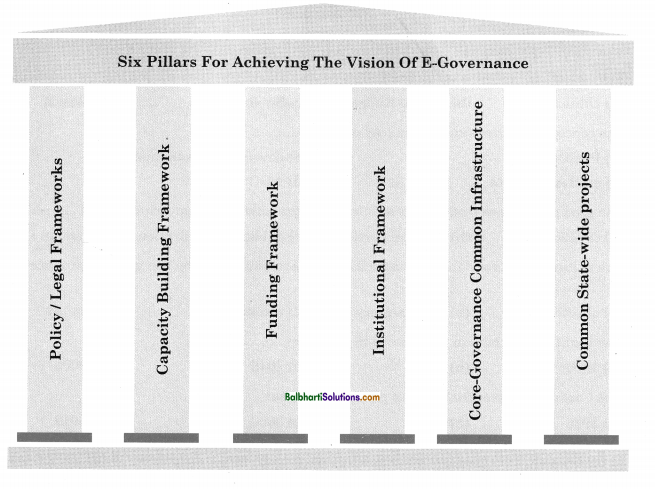By going through these Maharashtra State Board Class 12 Political Science Notes Chapter 5 Contemporary India: Good Governance students can recall all the concepts quickly.
Maharashtra State Board Class 12 Political Science Notes Chapter 5 Contemporary India: Good Governance
Introduction
→ Meaning of Governance: In development administration, not only the government but also citizens and NGO’s play a vital role. The term ‘governance’ is used to describe this cooperative effort of the government and non-governmental bodies in public administration.
Governance is broader than government as :
→ It includes formal institutions of government e.g., legislature, bureaucracy as well as informal institutions e.g. NGO’s.
→ It aims to improve the performance of public institutions with focus on values like accountability, transparency, citizen feedback, etc.
In the 1990s several changes took place in the world:
→ Globalisation of the world economy – This included technological revolution, growth of social networking and transparency in the administrative system. There were changes in international economic relations due to which investment and trade and commerce became important.
→ International Institutions – International funding agencies like IMF, World Bank, UNDP have become influential in bringing about administrative reforms in Third World Nations.
→ Non-State actors – NGO’s, private sector organizations, civil society have started to play a greater role in public administration.
![]()
Meaning Of Good Governance:
The Good Governance approach aims at the following.
- to reform the traditional, huge-sized public administration which was riddled with red tape and corruption.
- to replace the archaic systems with responsible, participative and equitable systems.
- to look at interlinkages between government and civil society.
- to make the administration citizen-centred and not merely rule-bound.
Value Of Good Governance

→ Participation – The effective functioning of any democratic system requires that people get an opportunity to participate in the process of decision making and its implementation.
→ Rule of law -The constitution and law of the land is a core value of good governance. It ensures a just and fair polity where rights of citizens are safeguarded.
→ Effectiveness and efficiency – All processes and institutions must produce results that meet the needs of society but also making sustainable use of natural resources and protecting the environment.
→ Consensus oriented – Good governance requires dialogue between various sections of society to reach consensus on what is best for the entire community and how to achieve it. It requires a long-term perspective on how to best achieve the goals of sustainable human development.
→ Responsiveness – The government must be prompt and sensitive while designing policies to serve all stakeholders within a reasonable timeframe.
→ Equity and inclusiveness – No stakeholder, especially the vulnerable should feel excluded from the mainstream of society. All persons should have opportunities to improve their well-being.
→ Transparency – This value of good governance enables people to keep the government under scrutiny for e.g. Right to Information Act (2005) provides citizens access to information about public policies and actions
→ Accountability: This cannot be enforced without the rule of law and transparency. Any organization is accountable to those who will be affected by its decisions and actions, i.e., to stakeholders. Governmental institutions, private sector and civil society institutions must be accountable
![]()
Initiatives For Good Governance In India:
After independence, India adopted a socialist model of development which aimed at achieving a Welfare State. The Department of Administrative Reforms and Public Grievances looks after administrative reforms in India.
Its objectives are –
- to promote administrative reforms in government policies and processes.
- to promote citizen-centric governance.
- to conduct innovations in e-governance.
The Second Administrative Reforms Commission (ARC) was set up in 2005 to prepare a blueprint for revamping the public administration system in India.
It looked at the following issues
- To make public administration accountable, transparent, efficient, responsive and result-oriented.
- Citizen centric, participative administration.
Reform measures/initiatives for administration include:
- Simplifying administrative procedures, using technology to improve internal efficiency and reducing regulatory control.
- Enacting laws giving certain rights to citizens and setting up institutional mechanisms to
redress grievances.
![]()
Specific Programmes To Bring About Good Governance In India:
Lokpal and Lokayukta: The Lokpal and Lokayuktas Act (2013) provides for the establishment of Lokpal (at the Union level) and Lokayuktas (in the States) to inquire into allegations of corruption against public officials. This is a commitment to a responsive, clean governance. The Maharashtra Lokayukta Institution came into being in 1972.
Citizen’s Charters: The exercise to formulate Citizen’s Charters began in 1996. Each organisation must spell out the services it has to perform and the standards/norms for these services. If these standards are not met then, that agency can be held accountable.
E-Governance: In the last few decades, governance has become more complex and varied. Citizens expectations from the government have also increased. Information and Communications Technology (ICT) is used in governance. This is called ‘e-governance’.
It helps in
- instant transmission and processing information and efficient storing and retrieval of data.
- increasing the reach of government both geographically and demographically.
- speeding up decision making and increasing transparency and accountability of government processes.
E-governance in India has evolved from computerisation of departments to initiatives which are citizen-centric and service-oriented.
Six Pillars For Achieving The Vision Of E-Governance

Right to Information: It is a basic necessity of good governance which enables citizens to seek important public information from the government i.e., about public policies and actions. Transparency in government institutions makes them function more objectively and enables citizens to participate effectively in the governance process.
![]()
Citizen participation: Citizen participation refers to the following aspects.
→ The development process is a “bottom-up” approach in which citizens are not recipients but participants in this process.
→ Citizens have a right in making decisions pertaining to themselves.
→ There are modalities by which citizens can take control of resources or influence decision making.
→ It contributes to a responsive, participative democracy.